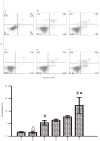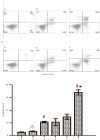Wip1 gene silencing enhances the chemosensitivity of human colon cancer cells
- PMID: 28781635
- PMCID: PMC5530189
- DOI: 10.3892/ol.2017.6361
Wip1 gene silencing enhances the chemosensitivity of human colon cancer cells
Abstract
Colon cancer is one of the most common cancers in the world. Multidrug resistance is one of the main reasons for failure of therapy in patients with advanced colon cancer. In previous studies, multiple methods were investigated to reverse the multidrug resistance of colon cancer cells. However, to date, no clinical method has been identified to be satisfactory. Therefore, successful reversal of drug resistance in colon cancer cells still requires new therapeutic strategies or pharmaceuticals. Wild-type p53-induced phosphatase (Wip1), a member of the 2C type serine/threonine protein phosphatase family, is closely associated with the p53 gene, which is the most important tumor-suppressor gene. Wip1 was reported to be associated with the chemosensitivity of breast cancer cells. However, the correlation between the expression of Wip1 gene and the chemosensitivity of colon cancer cells has not been reported yet. In the present study, Wip1-811 small interfering RNA (siRNA) targeting Wip1 was investigated to reverse the multidrug resistance of colon cancer cells. The siRNA duplexes were transfected into RKO colon cancer cells. The messenger RNA (mRNA) expression of Wip1 was measured by reverse transcription-quantitative polymerase chain reaction. The protein level of Wip1 was detected by western blotting. The cell viability was measured by MTS assay. The cell apoptosis and cell cycle were analyzed by flow cytometry. Intracellular adriamycin cumulative concentration was determined using flow cytometry. Wip1-811 siRNA efficiently inhibited the expression of Wip1 at the mRNA and protein levels, and enhanced the sensitivity of RKO colon cancer cells towards chemotherapy, which was accompanied by increased cell apoptosis, following the inhibition of Wip1 gene expression. These results indicate that Wip1 gene silencing could enhance the chemosensitivity of colon cancer cells, which may provide a new potential approach for the reversal of multidrug resistance in colon cancer cells.
Keywords: Wip1 gene; chemosensitivity; colon cancer; small interfering RNA.
Figures








Similar articles
-
Wip1 regulates SKOV3 cell apoptosis through the p38 MAPK signaling pathway.Mol Med Rep. 2017 Jun;15(6):3651-3657. doi: 10.3892/mmr.2017.6469. Epub 2017 Apr 12. Mol Med Rep. 2017. PMID: 28440479 Free PMC article.
-
p53-Independent expression of wild-type p53-induced phosphatase 1 (Wip1) in methylmethane sulfonate-treated cancer cell lines and human tumors.Int J Biochem Cell Biol. 2012 Jun;44(6):896-904. doi: 10.1016/j.biocel.2012.02.013. Epub 2012 Feb 24. Int J Biochem Cell Biol. 2012. PMID: 22405851
-
Reversal of multidrug resistance by transduction of cytokine genes into human colon carcinoma cells.J Natl Cancer Inst. 1996 Oct 2;88(19):1383-92. doi: 10.1093/jnci/88.19.1383. J Natl Cancer Inst. 1996. PMID: 8827016
-
Wip1 phosphatase: between p53 and MAPK kinases pathways.Oncotarget. 2016 May 24;7(21):31563-71. doi: 10.18632/oncotarget.7325. Oncotarget. 2016. PMID: 26883196 Free PMC article. Review.
-
Wip1: A candidate phosphatase for cancer diagnosis and treatment.DNA Repair (Amst). 2017 Jun;54:63-66. doi: 10.1016/j.dnarep.2017.03.004. Epub 2017 Mar 20. DNA Repair (Amst). 2017. PMID: 28385459 Review.
Cited by
-
PPM1D in Solid and Hematologic Malignancies: Friend and Foe?Mol Cancer Res. 2022 Sep 2;20(9):1365-1378. doi: 10.1158/1541-7786.MCR-21-1018. Mol Cancer Res. 2022. PMID: 35657598 Free PMC article.
-
The role of PPM1D in cancer and advances in studies of its inhibitors.Biomed Pharmacother. 2020 May;125:109956. doi: 10.1016/j.biopha.2020.109956. Epub 2020 Jan 29. Biomed Pharmacother. 2020. PMID: 32006900 Free PMC article.
-
Differential roles of the Wip1-p38-p53 DNA damage response pathway in early/advanced-stage ovarian clear cell carcinomas.World J Surg Oncol. 2022 Apr 30;20(1):139. doi: 10.1186/s12957-022-02600-7. World J Surg Oncol. 2022. PMID: 35490254 Free PMC article.
-
Oncogenic WIP1 phosphatase attenuates the DNA damage response and sensitizes p53 mutant Jurkat cells to apoptosis.Oncol Lett. 2021 Jun;21(6):479. doi: 10.3892/ol.2021.12740. Epub 2021 Apr 19. Oncol Lett. 2021. PMID: 33968195 Free PMC article.
-
SERPINA3 Silencing Inhibits the Migration, Invasion, and Liver Metastasis of Colon Cancer Cells.Dig Dis Sci. 2018 Sep;63(9):2309-2319. doi: 10.1007/s10620-018-5137-x. Epub 2018 May 31. Dig Dis Sci. 2018. PMID: 29855767
References
-
- Douillard JY, Cunningham D, Roth AD, Navarro M, James RD, Karasek P, Jandik P, Iveson T, Carmichael J, Alakl M, et al. Irinotecan combined with fluorouracil compared with fluorouracil alone as first-line treatment for metastatic colorectal cancer: A multiple multicentre randomised trial. Lancet. 2000;355:1041–1047. doi: 10.1016/S0140-6736(00)02034-1. - DOI - PubMed
-
- Redmond SM, Joncourt F, Buser K, Ziemiecki A, Altermatt HJ, Fey M, Margison G, Cerny T. Assessment of P-glycoprotein, glutathione-based detoxifying enzymes and O6-alkylguanine-DNA alkyltransferase as potential indicators of constitutive drug resistance in human colorectal tumors. Cancer Res. 1991;51:2092–2097. - PubMed
-
- Xia Z, Zhu Z, Zhang L, Royal C, Liu Z, Chen Q, Adam BL. Specific reversal of MDR1/P-gp-dependent multidrug resistance by RNA interference in colon cancer cells. Oncol Rep. 2008;20:1433–1439. - PubMed
LinkOut - more resources
Full Text Sources
Other Literature Sources
Research Materials
Miscellaneous
